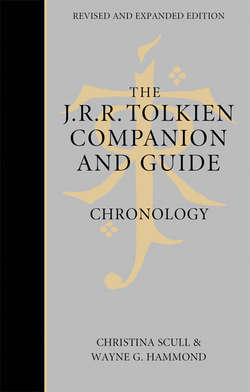Читать книгу The J. R. R. Tolkien Companion and Guide: Volume 1: Chronology - Christina Scull - Страница 29
Оглавление1907
Spring term 1907 Ronald enters the Second Class at King Edward’s School, under both Robert Cary Gilson, the Head Master, and his assistant A.E. Measures, and in Section A5 for Mathematics and Arithmetic under Assistant Master P.M. Marples. Hilary Tolkien is now in Class IX, Section D4.
4 April 1907 Field Marshal Earl Roberts visits King Edward’s School, as one of four public engagements in Birmingham. He inspects the newly formed Cadet Corps (*Societies and clubs), of which Tolkien is now a member. A photograph is taken of the assembled group of some 120 cadets. See note. After the inspection, Lord Roberts gives an address in the School hall, encouraging the boys to learn to shoot and to understand that it is not only his duty, but an honour and privilege, to defend his country.
27 and 29 June 1907 Athletic Sports are held at the King Edward’s School Grounds.
31 July 1907 Speech Day and prize-giving at King Edward’s School. Now at the end of the summer term, Ronald is placed fourth out of twenty in his general class, and eighth in Section A5.
Summer 1907 Father Francis again takes Ronald and Hilary to Lyme Regis. He learns from them that they are not happy living with their Aunt Beatrice.
Autumn term 1907 Ronald enters the First or Senior Class, under Robert Cary Gilson and A.E. Measures; he will remain in this uppermost class, under the same instructors, for the rest of his years at King Edward’s School. There are twenty-two boys in the class, listed by seniority rather than by term work or examination results; among these is *Wilfrid Hugh Payton (known as ‘Whiffy’), who will be one of the members of the *T.C.B.S. during Ronald’s last term at school. Gilson is an inspiring teacher who tries to interest his pupils in classical linguistics and philology, but also encourages them to branch out in their studies. Ronald will later recall that on many occasions the Head Master imposed on him the writing of lines, such as ‘punctuality is the soul of business’ and ‘brevity is the soul of wit’. During this term Ronald is in Section A5 for Mathematics and Arithmetic, again under P.M. Marples, in which he will end the term ranked third. Hilary Tolkien is now in the Upper Remove, Section D3. – Apart from his official studies, Ronald is already pursuing interests in Old English (Anglo-Saxon) and Middle English. He feels a special sympathy and even a sense of recognition for Middle English works such as *Sir Gawain and the Green Knight and *Pearl, written in the West Midlands dialect which he thinks was spoken by his mother’s West Midlands ancestors. He even begins to learn Old Norse in order to read the story of Sigurd in the original. He also reads books on philology and the history of language, and begins to buy books secondhand. He is learning a lot, developing an interest in philology and a deep appreciation of the look and sound of words. He also discovers Esperanto and learns enough of its grammar and structure to be able to read works written in it. Probably at about this time he begins to create for himself a language to suit his own aesthetic tastes: Naffarin, influenced by Latin and Spanish. – He is not alone at King Edward’s School in his unusual interests: Christopher Wiseman is studying Egyptian and its hieroglyphics, while *Geoffrey Bache Smith, who will later become a close friend, is interested in Welsh.
